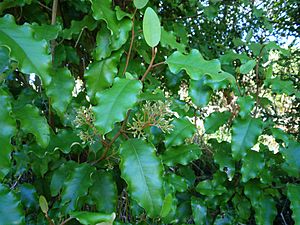Akiraho facts for kids
Quick facts for kids Akiraho |
|
|---|---|
 |
|
| Scientific classification | |
| Genus: |
Olearia
|
| Species: |
paniculata
|
| Synonyms | |
|
Shawia paniculata J.R.Forst. & G.Forst. |
|
The Olearia paniculata, often called akiraho, is a special type of shrub or small tree. It belongs to the Asteraceae family, which includes plants like daisies. You can only find this plant growing naturally in New Zealand.
The akiraho tree can grow up to 6 metres tall, which is about the height of a two-story building! It has cool yellow-green leaves that are shaped like ovals. The underside of the leaves is white, and their edges are often wavy. In late autumn, this plant grows clusters of small, white flowers that look like tiny daisies.
Contents
What is Akiraho?
The akiraho (Olearia paniculata) is a small evergreen tree native to New Zealand. This means it stays green all year round and is found only in New Zealand. It grows on both the North and South Islands.
The tree has reddish branches with smooth, wavy-edged green leaves. The underside of these leaves is white. The branches also have grooves on their top surface. Akiraho can grow quite tall, reaching about 6 metres. Its flowers are small and white, growing in thick bunches. The plant also has a sweet smell, which makes it popular for creating hedges in gardens. The name "paniculata" means "small sprayed," which describes its flower clusters.
Where Does Akiraho Grow?
Its Home in New Zealand
The akiraho tree is found only in New Zealand. It grows naturally across a wide area, from the East Cape on the North Island all the way down to South Canterbury on the South Island. While it's not originally from the Taranaki region, you can often see it growing there as a popular hedge plant.
Where Akiraho Likes to Live
Akiraho plants often grow in places with lots of grass. You might also find them near other shrubs, herbs, and ferns that grow on the forest floor. This plant loves dry soils and windy spots, which is why it's common in areas near the coast.
It prefers sunny or partly shady spots with soil that drains water well. It can handle coastal conditions and dry, windy weather, which helps it avoid getting too much water. Akiraho can also survive mild frosts, but it doesn't like soil that is always wet. You won't usually find this species growing in very old, natural forests.
How Akiraho Lives and Grows
Life Cycle of Akiraho
The akiraho plant produces its small, daisy-like flowers in late autumn. It grows best after the autumn rains because the soil is soft, moist, and warm. This helps the plant get strong before winter arrives. Akiraho usually starts to flower between March and May. Then, it produces its fruits between April and July.
Who Eats Akiraho?
Good news! The akiraho plant doesn't have any known pests or diseases that bother it. However, animals like goats, cattle, and sheep sometimes enjoy munching on its leaves.
Growing Akiraho Plants
If you want to grow Olearia paniculata, it needs water, but not too much. Its thick leaves help it save water and protect itself. Akiraho prefers soil that has been softened and warmed by autumn rains. This type of soil is perfect for the plant to settle in.
When planting akiraho, it's a good idea to put it in slightly raised garden beds. This helps the water drain away and allows the roots to get enough air. Like all young plants, akiraho needs plenty of water during dry periods for its first few years. Adding mulch around the plant helps keep the soil moist and stops weeds from growing. Mixing coarse sand, compost, or other organic materials into the soil can make it healthier and better at holding moisture.
When you plant akiraho, make sure its roots are well-soaked with water. Dig a hole that is twice as wide as the plant's root ball, and water it again once the plant is in the ground.
Other Interesting Facts
The flowers of the akiraho plant have a sweet smell. You usually don't need to trim this plant unless you are growing it as a hedge. If it's a hedge, you'll need to trim it regularly to keep it neat.

